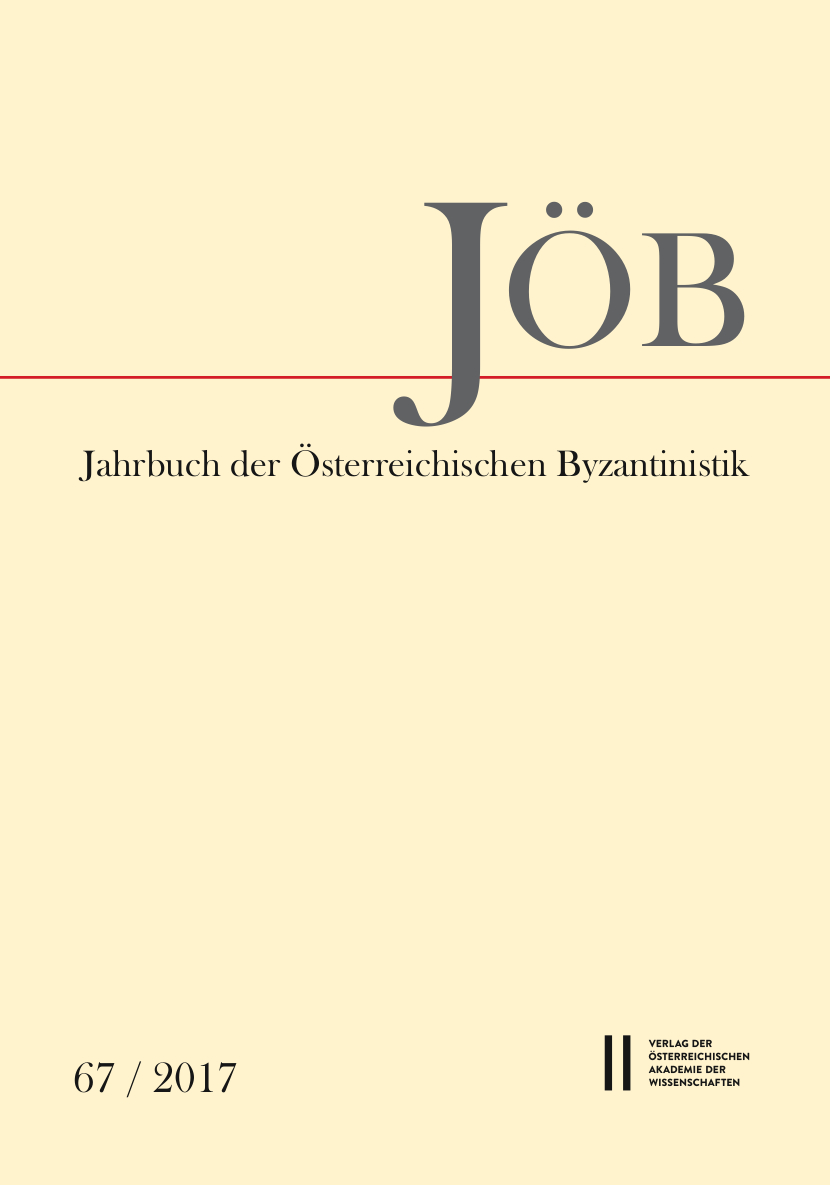Ewald KISLINGER
ist Professor am Institut für Byzantinistik und Neogräzistik der Universität Wien
|
 |
Arne EFFENBERGER, Die Atik Mustafa Paa Camii und weitere Kirchen zwischen Zeugma und Blachemen
Angeliki KATSIOTI -Georges KIOURTZIAN, L'eglise de Saint-Jean le Theologien de Leros (Dodécanèse) et la dedicace de l'eveque Nikolaos
Manfred KERTSCH, Ein Reflex der zweiten Rede des Pseudo-Demosthenes „Gegen Aristogeiton" (or. 26,3) bei Isidor von Pelusion, ep. 1657
Sebastian KOLDITZ, Byzanz und das Konstanzer Konzil (1414-1418). Beobachtungen zur griechischen Präsenz und zur vorkonziliaren Korrespondenz Sigismunds und Manuels II .
Dirk KRAUSMÜLLER, Athanasius, the Author of Vita A of Athanasius the Athonite, on Secular Education, Legal Theory, Mysticism and Asceticism
Jose MAKSIMCZUK, The Textual Tradition of the Florilegium Hierosolymitanum (and its Relations with the Florilegium Coislinianum)
Petra MELICHAR, Imperial Women as Emissaries, Intermediaries, and Conciliators in the Palaiologan Era
Nicholas MELVANI, The Monastery of Stoudios in the Century
Susanne METAXAS -Paraskevi TRITSAROLI, Gathering the Very Young. A Contribution to Early Byzantine Burial Practises Based on the Contextual Analysis of a Children's Grave Found in Ancient Pallantion (Arcadia, GR)
Martin MULZER, Zum lateinisch-griechischen Glossar von Avranches
Claudia RAPP -Eirini AFENTOULIDOU -Daniel GALADZA - Ilias NESSERIS - Giulia RossETTO - Elisabeth SCHIFFER, Byzantine Prayer Books as Sources for Social History and Daily Life
Werner SEIBT, Wer war Niketas Nobellisimos und Kornes von Opsikion (8. Jahrhundert)?
Luigi SILVANO, Perche leggere Omero: il prologo all'Odissea di Manuele Gabala nelle due redazioni autografe
Anastasia SIROTENKO, Forgetting the Heretic: the Emperor Heraclius in the Byzantine Liturgical Tradition
Besprechungen
Anastassios Ch. ANTONARAS, Arts, Crafts and Trades in Ancient and Byzantine Thessaloniki . Archaeological, Literary and Epigraphic Evidence (Peter Soustal)
Fozio, Biblioteca Introduzione di Luciano CANFORA; nota sulla tradizione manoscritta di Stefano MICUNCO ( Domenico Accorinti)
Die byzantinischen Häfen Konstantinopels, hrsg. von F. Daim ( Paul Magdalino)
BARTOLOMEO Di SALVO, Chants of the Byzantine Rite: The Italo-Albanian Tradition in Sicily. Canti ecclesiastici della tradizione Italo-Albanese in Sicilia (Gerda Wolfram)
Tim GREENWOOD, The Universal History of Step'anos Tarönec'i. Introduction, Translation and Commentary ( Werner Seibt)
Ravenna. Its Role in earlier medieval change and exchange, ed. J. Herrin - J. Nelson (David Schmid)
Hava and Sali HIDRI, Die frühchristiliche Basilika in Arapjai/Dures (Albanien), hrsg. von Renate Pillinger (Verena Fugger)
Michael KAPLAN, Pourquoi Byzance? Un Empire de once siècles (Peter Schreiner)
Urs PESCHLOW, Ankara. Die bauarchäologischen Hinterlassenschaften aus römischer und byzantinischer Zeit. Mit einem Beitrag von Wolfram Brandes (Ursula Quatember)
Claudia RAPP, Brother-Making in late Antiquity and Byzantium. Monks, Laymen and Christian Ritual (Charis Messis)
HELMUT RIEDL, Mittelalterliche Wehrsiedlungen in der Ägäis und an der nördlichen Adria (Peter Soustal)
Georgii Cedreni Historiarum compendium, edizione critica a cura di Luigi TARTAGLIA (Erich Trapp)
Ionut-Alexandru TUDORIE, Autoritatea imperialä in crizä. Mihail al VIII-lea Paleologul (1258 1282) i raporturi lui bizantin cu Biserica ( Mihai-D. Grigore)
Clement W1NGLER, Construire pour soumettre. L'image du basileus dans la litterature franaise et allemande de des (Zuzana Cernakova)
|

